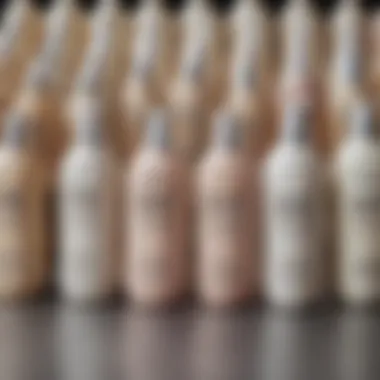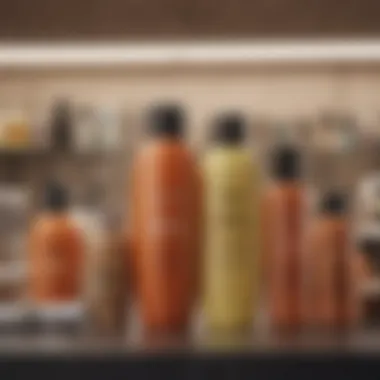Essential Tools for Safe and Effective Hair Bleaching


Intro
Hair bleaching is more than just a trend; it is an intricate process that can significantly alter one's appearance. Whether you are looking to achieve a vibrant platinum look or just lighten your natural shade, understanding the necessary items and precautions is crucial. This article will delve into the essential tools and products you need for hair bleaching, along with proper usage and safety measures to ensure the best results.
Beauty Trends
In recent years, the beauty industry has embraced a vibrant range of hair colors and styles, making hair bleaching a popular option among individuals seeking to express themselves. From pastel shades to bold colors, hair bleaching serves as a foundation for achieving various looks.
When it comes to creating stunning hair colors, the right products can make all the difference. Bleach and developer are the primary items that are fundamental in the bleaching process. The strength of the developer plays a significant role in the outcome of the bleaching. For example, a 20-volume developer is often suitable for lighter shades, while a 30-volume developer may be necessary for more dramatic lift.
After preparing the hair, it is important to focus on protective gear. Items like gloves and a cape not only protect the skin from irritation but also ensure that the bleaching process is conducted safely and effectively. Ponce or foils can also help in separating the hair sections when applying bleach.
Following the application, proper aftercare products become essential. Using a quality toner helps to neutralize unwanted yellow or brassy tones often left after bleaching. Additionally, deep conditioners can nourish the hair and restore moisture lost during the bleaching process.
Key Products and Their Functions
Bleach and Developer
Bleach is the primary agent that lifts the natural color from your hair. The developer, typically hydrogen peroxide, works alongside the bleach to open the hair cuticle and facilitate the lifting process. Choosing the right ratio of bleach to developer is crucial for effective results.
Protective Gear
- Gloves: Protects skin from potential irritation.
- Cape: Shields clothing from bleach stains.
- Foils or Wraps: Helps in sectioning the hair effectively.
Application Tools
- Brush and Bowl: Essential for mixing and applying the bleach evenly.
- Comb: Useful for detangling and sectioning the hair.
Aftercare Products
- Toner: Helps to achieve the desired hair color.
- Deep Conditioner: Replenishes moisture and enhances shine.
"Proper preparation makes all the difference in achieving a successful bleaching outcome."
Precautions to Consider
Using bleach comes with risks. It is essential to conduct a patch test before the actual application to check for allergic reactions. Also, never apply bleach on damaged or unhealthy hair, as this can cause further harm.
Timing is crucial during the bleaching process. Keep a close watch on the developing time to prevent over-processing, which can lead to brittleness and breakage. Always follow the manufacturer's instructions regarding the products you use.
Preface to Hair Bleaching
Hair bleaching is a process that significantly alters the natural color of hair, and it requires a careful approach. This section highlights the necessity of understanding the basics before engaging in the bleaching process. The significance of this topic extends beyond mere aesthetics; knowledge of hair bleaching can help in making informed choices and avoiding potential pitfalls.
The importance of comprehending hair bleaching lies in its multifaceted nature. First, bleaching hair can dramatically transform one's appearance, providing a bold change or a fresh look. However, it is crucial to navigate this process with a clear understanding of the methods, products, and potential side effects. To achieve the desired result, individuals must familiarize themselves with the intricacies involved in hair bleaching.
Engaging with this topic will benefit anyone considering a change in hair color. It emphasizes that preparation, patience, and knowledge are vital for successful bleaching. The subsequent sections delve deeper into the essential tools and products needed for safe and effective bleaching, ensuring that the reader is well-equipped to carry out the process with confidence.
Understanding Hair Bleaching
Hair bleaching involves the chemical alteration of hair dye, primarily using bleach powder mixed with a developer. The primary aim is to strip hair of its natural pigment, resulting in a lighter shade. Understanding this process is crucial for achieving the desired results without compromising hair health. The blending of these ingredients results in a reaction that lifts the color, making the hair lighter, though it can also cause damage if not done properly.
The scale of hair color is essential in this discussion. It ranges from light to dark hues, and the lighter the desired outcome, the stronger the developer and bleach used will have to be. Knowing how this interplay works helps in selecting the right products and application technique.
Why People Choose to Bleach Their Hair


There are multiple reasons individuals opt for hair bleaching. First and foremost, it serves as a powerful tool for personal expression. Many see bleaching as a way to embrace new trends or reinvent their identity. Bold colors and lighter shades can signify phases of life, personality, or even status within social circles.
Another reason could be the desire to cover up grey hair or enhance existing hair colors. Bleaching allows for creating a base that other colors can adhere to better. In some instances, it prepares the hair for unique tones that might not show well otherwise, such as pastels or vivid colors.
Moreover, the allure of changing one’s look—whether for special occasions or simply to feel refreshed—is a compelling factor driving this decision. Simple and straightforward, the option of bleaching opens a door to creativity and individuality without requiring permanent changes. However, this process must be approached with caution.
"Bleaching hair is as much an art as it is a science. Knowing the why and how is the key to success."
Essential Bleaching Products
Essential bleaching products play a crucial role in the hair bleaching process. These items not only contribute to the effectiveness of the bleaching but also impact the overall health of the hair. Selecting the right products can make a significant difference in the final outcome, ensuring that the bleaching is successful and that hair remains as undamaged as possible. This section will cover the fundamental components of hair bleaching: bleach powder, developer, and hair toner.
Bleach Powder
Types of Bleach Powder
There are various types of bleach powder available in the market, which can affect the bleaching process. Mainly, bleach powders are categorized into two types: traditional and oil-based powders. Traditional bleach powders are known for their strong lifting abilities. They tend to be faster in processing, making them a popular choice for many. In contrast, oil-based powders are gentler. Their special formulation helps to minimize moisture loss, which is beneficial for maintaining hair integrity during the bleaching process.
Both types have unique features and advantages. Traditional powders are effective for quick results, while oil-based products provide a more nourishing effect. Choosing between the two depends on individual hair needs and desired outcomes.
Choosing the Right Bleach Powder
Choosing the proper bleach powder is vital for achieving the desired hair color while minimizing damage. Factors to consider include hair type, desired lift, and sensitivity. For fine hair, a lower strength bleach is advisable, as it is more prone to damage. Conversely, thicker hair may require stronger bleach to achieve the same results. The texture of hair also plays a role in selection; coarser hair may need a higher strength product for effective lifting.
Additionally, the powder's source and formulation can affect performance. Always opt for a bleach product that aligns well with specific hair goals. Incorrect choices can lead to undesired results, so understanding the unique formulation is essential.
Developer
Understanding Developer Levels
The developer is a crucial component of the hair bleaching process, as it acts as the activator. Developer levels are usually indicated by a number, ranging from 10 to 40, with each level providing different degrees of lift. For instance, a 10-volume developer provides minimal lift and is best for deposit-only colors or for use with treatments requiring no lift. On the other hand, a 40-volume developer is used for maximum lift.
Understanding these levels is vital for selecting the right developer. Using a higher volume developer than necessary can lead to excessive damage. Therefore, knowing the hair's condition and the desired outcome is necessary to choose correctly.
Selecting the Appropriate Developer
Selecting the appropriate developer goes hand in hand with bleach powder selection. Matching the developer with the bleach powder is essential for achieving optimal results. The wrong developer may either under-process or over-process the hair. For instance, if using oil-based bleach powder, pairing it with a gentle developer will yield better results.
Individual preferences and hair condition should dictate the choice of developer. A careful assessment can help achieve the desired lift while ensuring hair maintains its health. Therefore, experimenting with different combinations may be required to find the perfect match.
Hair Toner
Purpose of Hair Toners
Hair toners are important products used after bleaching to neutralize unwanted tones in the hair. The main goal of a toner is to cancel out hair shades that are too yellow or brassy. Toners can also enrich the overall color, adding depth and richness. Without using a toner, the hair may end up with undesirable hues, which can detract from the intended effect of the bleach process.
Choosing a suitable toner depends on the underlying tones in the hair after bleaching. For instance, a purple toner is effective against yellow tones, whereas a blue toner can combat orange hues. Having the right toner on hand is crucial to achieving a polished and natural-looking final result.
Choosing the Right Toner
Choosing the right toner involves understanding the desired hair outcome and the specific color corrections needed. Considerations include the color wheel; for example, knowing which colors counteract others is essential. Additionally, the form of toner, whether liquid or cream, can influence application techniques and results.
Always assess the hair color post-bleach before applying the toner. This approach helps in selecting a toner that accurately targets and neutralizes dreadful undertones effectively. The right toner can greatly enhance the final look, making it a necessary item in the hair bleaching process.
Application Tools


When it comes to hair bleaching, the choice of application tools can greatly impact both the process and the overall result. The right tools ensure an even application of the bleach, minimize mess, and safeguard the user from potential hazards. Therefore, selecting appropriate application tools plays a critical role in achieving the desired hair color while also ensuring a safer experience.
Mixing Bowl
A mixing bowl is a fundamental tool in the hair bleaching process. It is used to combine bleach powder with developer, creating the mixture needed for application.
Material Considerations
The material of the mixing bowl matters significantly. Plastic and glass bowls are common choices, each with its pros and cons. Plastic bowls are lightweight and usually less expensive, making them a popular option. However, they can stain over time from the chemical mixtures. Glass bowls, on the other hand, are more durable and resistant to staining. They provide a non-reactive surface that does not interact with the bleaching agents, which can be a healthier choice for your hair. Thus, choosing between these materials depends on personal preference and specific needs.
Size and Shape
The size and shape of the mixing bowl can affect the mixing process. A larger bowl provides ample space for stirring and mixing ingredients without spilling. Ideally, a wide and shallow bowl is favorable as it allows for better visibility of the mixture and facilitates easy access when applying the product to hair. However, a larger bowl may not be necessary for all users, and a more compact bowl can fit easily in smaller spaces. Consideration of these factors will aid in better mixing and application.
Application Brush
An application brush is another vital tool. It enables the precise application of bleach to the hair, ensuring accuracy with every stroke.
Choosing the Right Brush
Choosing the right brush is crucial, as different brushes are designed for various application techniques. A wider brush is suited for larger sections of hair, while a narrower one is essential for precision work, especially around the roots or for highlighting. The bristles should be firm yet flexible, allowing them to easily distribute the bleach while following the hair strands. This is beneficial for achieving an even saturation without damaging the hair.
Technique for Application
Using the proper technique can enhance the results of the bleaching process. It is essential to apply the bleach in sections, starting from the bottom and working upwards. This method ensures that all strands receive equal attention, preventing uneven coloring. Holding the brush at an angle can help achieve a smoother application. Practicing patience and precision will provide the most appealing outcomes, contributing to the overall quality of the hair bleaching experience.
Comb
A comb is an often underestimated tool in the hair bleaching process. It aids in sectioning the hair and ensuring an even application of bleach.
Importance of a Comb
The importance of a comb cannot be overstated. It helps to detangle the hair before bleaching, reducing the chance of knots that can lead to uneven color absorption. Additionally, sectioning the hair with a comb allows for a systematic approach to applying bleach. This organized manner contributes to a more uniform result. Therefore, having a reliable comb is essential for anyone undertaking the bleaching process.
Different Types of Combs
There are various types of combs available, each serving a specific purpose. For hair bleaching, fine-toothed combs are often favored for their ability to smoothly detangle hair, while wide-toothed combs can help in quickly sectioning larger amounts of hair. The choice of comb should reflect the user's hair type and desired outcome. A fine-toothed comb may be more suited for thin hair, while a wide-toothed comb works well for thick and voluminous hair. Knowing which comb to use can enhance the effectiveness of the bleaching process.
Safety and Protection Gear
Safety and protection gear is a crucial component when undertaking the hair bleaching process. Hair bleach contains strong chemicals that can be harmful to skin and respiratory health. Protecting oneself from these agents is not just about comfort; it is critical to avoid allergic reactions and chemical burns. Additionally, the right protective measures can make the bleaching procedure smoother and reduce the risk of unintended consequences. Understanding the various pieces of safety gear can greatly enhance the overall experience and outcome.
Gloves
Choosing the Right Gloves
When selecting gloves for hair bleaching, it is important to consider the material. Nitrile gloves are often favored due to their durability and chemical resistance. This ensures that the bleach will not penetrate the gloves, providing a safer experience. Latex gloves can also work, but some individuals may have allergies to latex proteins. Choosing nitrile gloves can eliminate this risk, making them a beneficial choice for anyone undergoing the bleaching process. The fit is another important factor; snug gloves help prevent any contact of bleach on the skin, keeping the user protected.
Importance of Gloves in Process
Wearing gloves in the hair bleaching process is essential to prevent skin irritation. The bleach can cause harsh reactions, especially with sensitive skin. By using gloves, the risk of such irritations is significantly reduced. This protective layer not only safeguards the skin but also allows for a more focused application. It is important to change gloves regularly if they show any signs of damage or contamination. Overall, wearing gloves enhances the safety of the procedure, allowing for a more assured and effective bleaching session.
Protective Clothing
Types of Protective Clothing


Protective clothing encompasses various garments designed to shield the body from harmful chemicals. A common choice is a salon cape or an old t-shirt that you do not mind spoiling. These items help prevent bleach from seeping onto regular clothing, which can stain. Additionally, some may opt for a full-length smock or a lab coat that covers all clothing areas. Using protective clothing is a popular choice, as it minimizes accidental bleach spills. However, it is crucial to ensure that the clothing is non-absorbent to avoid direct skin contact, providing an additional layer of protection.
Why Protection is Necessary
Understanding why protection is necessary during hair bleaching cannot be overstated. Hair dye and bleach can lead to skin irritation and allergic reactions if they come into contact with sensitive areas. For example, areas such as the neck and wrists are more susceptible to adverse reactions. Using protective clothing can therefore safeguard against these potential chemicals in a layered manner. It not only adds physical protection but also offers peace of mind, allowing individuals to focus on achieving their desired hair color without concern for accidental damage to their skin or clothes.
Face Mask
Role of a Face Mask
Wearing a face mask while bleaching hair is important for guarding against inhaling toxic fumes. Hair bleaches often release strong vapors that can irritate the respiratory system. A well-fitted mask can create a barrier between the user and these harmful chemicals, making the process safer and more comfortable. Opting for masks that filter out chemical fumes ensures better respiratory health and enhances safety during the bleaching session. The added protection from inhalation helps minimize discomfort, achieving the intended results without health risks.
Choosing Appropriate Masks
When selecting a face mask, it is imperative to consider its filtering capabilities. Masks should ideally be certified for chemical protection, which indicates they are designed to filter harmful substances effectively. Some choose industrial masks that offer higher levels of protection; these masks are designed for prolonged exposure and can handle the harsh chemicals involved in hair bleaching. While these options can be a bit more expensive, they are worth it for those regularly bleaching hair or with concerns about chemical sensitivities. The right mask contributes significantly to a safer and more resilient hair bleaching experience.
Post-Bleaching Care
Post-bleaching care is crucial in maintaining the integrity and appearance of bleached hair. Once the bleaching process is complete, the hair often requires specialized treatments to restore moisture and strength. This section outlines the importance of conditioners and treatments, as well as how to properly maintain hair color after bleaching.
Conditioners and Treatments
Necessity of Conditioners
Conditioners serve as a fundamental component of post-bleaching care. Bleaching can strip hair of its natural oils, leading to dryness and brittleness. Conditioners help to replenish moisture, making hair feel softer and more manageable. The key characteristic of these conditioners is their ability to penetrate the hair shaft and provide hydration and nourishment.
Using a good conditioner after bleaching is beneficial because it improves the hair’s overall texture and reduces the risk of breakage. Many conditioners formulated specifically for bleached hair contain nourishing ingredients such as keratin or argan oil. These ingredients enhance the elasticity of hair and help to repair damage. However, it is essential to choose the right product, as some conditioners may weigh hair down or leave residues.
Types of Post-Bleach Treatments
Post-bleach treatments extend beyond standard conditioners. They target specific issues that arise after bleaching, such as damage and color fade. Treatment options often include deep conditioning masks and protein treatments designed to restore structural integrity. The primary characteristic that sets these treatments apart is their concentrated formulations, which provide more intensive care compared to regular conditioners.
For example, a deep conditioning mask can hydrate the hair more deeply, making it a popular choice for individuals who have recently bleached their hair. These treatments may take longer to apply but can yield significant benefits in terms of texture and shine. Users should be aware of the potential for some treatments to be too heavy, possibly leading to greasy hair if used excessively.
Maintaining Hair Color
After the bleaching process, maintaining the desired hair color is often challenging. Careful management is necessary to extend the vibrancy and longevity of the color while preventing unwanted fading.
Using Color-Safe Products
Using color-safe products is essential in preserving the hue achieved through bleaching. These products are formulated to be gentle on color-treated hair and do not contain harsh sulfates that can strip color. One key characteristic of these products is their mild, nourishing formulas that protect hair color.
The benefit of using color-safe shampoos and conditioners is that they help prevent fading, making versatile choices for anyone who wants their color to last. Additionally, some products may include UV filters to protect against sun damage, extending the intensity of the hue. However, it is also critical to regularly check the product ingredients. Some so-called color-safe products may contain ingredients that irritate sensitive scalps.
Frequency of Maintenance
The frequency of maintenance directly impacts the longevity of bleached hair color. Regular touch-ups may be necessary to keep the hair looking fresh. The key is finding a balance, as too frequent bleaching can lead to further damage. A beneficial strategy is to schedule touch-up appointments every 6-8 weeks, depending on how quickly hair grows and fades.
The unique feature of this maintenance frequency allows individuals to manage their hair health actively while maintaining their desired look. However, personal circumstances, such as hair condition and lifestyle factors, should always guide frequency adjustments. Building a routine that respects the hair’s needs will ultimately lead to the best aesthetic results.
The End
Understanding the nuances of hair bleaching is crucial not only for achieving the desired look but also for ensuring the health and safety of your hair and scalp. This article has provided a detailed overview of the essential items required for effective hair bleaching, highlighting both their functionality and the precautions that need to be taken.
Final Thoughts on Hair Bleaching
The process of bleaching hair involves multiple steps, each requiring specific products and tools. It is vital to select the right bleach powder and developer, as these will determine the effectiveness of the bleaching process. Using suitable application tools like mixing bowls, brushes, and combs further enhances the precision of the procedure.
In addition, safety cannot be overlooked. Items like gloves, protective clothing, and face masks play a significant role in safeguarding against chemical irritation. This highlights the importance of preparation.
Post-bleaching care is equally important. Conditioners and treatments help maintain hair's integrity and vibrancy after the bleaching process. This not only preserves your new color but also promotes overall hair health.
In summary, this comprehensive guide reviews the fundamental elements of hair bleaching and emphasizes an informed approach to achieve beautiful results without compromising the condition of your hair. By paying close attention to the products used and following the detailed steps outlined, individuals can enjoy a successful hair bleaching experience.







